[Analytics] Trade war spooks the South Korean economy

Korean exports down: Pedestrians walk past a Samsung store in Shanghai. Photo: AFP. Sketched by the Pan Pacific Agency.
The intensified US-China trade war has spooked the South Korean economy, which had shown a sign of recovery. Slowing global demand has caused company inventories to rise, leading to a decline in factory utilization. The manufacturing sector’s inventory rate is at the highest level in more than two decades. Lee Shin-Hyung specially for the Asia Times.
Production levels dropped in Korea’s mining and manufacturing sectors, while investment in facilities also decreased in May.
The domestic sector fared a little better, with service sector output rising slightly and retail sales also returning to an increase, but the rebound was not strong enough to expect a substantial recovery in domestic demand.
Mood worsened after US tariffs
An official at the Ministry of Finance told Asia Times on Friday: “The decrease in exports eased in April and economic indicators showed signs of improvement. But the mood worsened sharply after the US-China trade war intensified from May 10, when the US government imposed tariffs with a rate of 25% on Chinese imports worth $200 billion.
“Early this year, we expected the memory chip prices to recover from the second half. But now, we think it is unlikely.”
The National Statistical Office said industrial output fell 0.5% in May from the previous month – the first decline in three months after rising 1.2% in March and 0.9% in April.
Mining and manufacturing output fell 1.7% on-month, which was also the first decline in three months in those sectors. Meanwhile, auto production rose 0.6%, but oil refining and metal processing fell 14% and 3.6%, respectively.
The average facility utilization rate in the manufacturing sector stood at 71.7%, down 1.0% from the previous month. Manufacturing inventories rose 0.9% month-on-month, while shipments fell 1.4%. The inventory rate rose to 118.5%, a 2.6% rise from the previous month.
Highest inventory level since 1998
The inventory level of 118.5% is the highest in 21 years – since the figure rose to 122.9% in September 1998.
Service sector output was up 0.1% in May, the first rise in three months. Wholesale and retail output was also up 1.8%, while the health and social welfare sector increased by 0.4%. On the other hand, lodging and restaurant business data declined 0.3%.
Retail sales inched up 0.9% from a month earlier, after a fall of 1.2% in the previous month. Sales of durable goods such as home appliances rose 0.6%, and sales of semi-durable goods like clothing increased by 4.9%. But, sales of non-durable goods such as food and beverage products fell 0.7%.
“There are many holidays in May, so domestic demand indicators tend to be good in May,” said Lee Sang-jae, an economist at Eugene Investment & Securities to Asia Times. “Nevertheless, it is difficult to expect a solid recovery in the domestic sector because the increase in retail sales in May was not significant,” he said.
Facility investment fell 8.2% on-month, the first decline in three months, due to such factors such as a fall in semiconductor investment.
Construction investment also fell 0.3% on-month due to a drop in both civil engineering and construction work.
The coincidence index, a gauge of current economic conditions, rose 0.2% on-month, marking the first rise in 14 months. However, the leading index, which shows the future economy, fell 0.2% from the previous month. The leading index rose for the first time in 11 months in April.
Rate cut widely expected
Experts said that industrial activities in May reaffirmed that sluggish exports stemming from the protracted and exacerbated US-China trade war are negatively affecting manufacturing output and investment.
The market predicted that along with the government’s expansionary fiscal policy, the Bank of Korea is likely to cut its policy rate.
“The worsening external conditions are leading to sluggish facility investment as well as manufacturing production,” said Stephen Lee, an economist at Meritz Investment & Securities. “Inventory is rising due to a lack of external demand, domestic demand has increased somewhat, but the recovery momentum is weak. It is hard to expect a solid recovery in domestic demand.
“The GDP growth rate for the second quarter will be determined by how much the government increases its spending, which was sluggish in the first quarter.” he continued. “I think BOK should also take a step toward lowering interest rates. We expect the Monetary Policy Board to cut the key interest rate in August.”
Lee Sang-jae of Eugene Investment & Securities also said: “When exports are sluggish due to worsening external conditions, domestic demand should grow to compensate for the weak export, but the May data showed that it would be still difficult to expect a recovery in domestic demand. It also revealed deepening inventory accumulation and a fall in the factory utilization rate.”
“If external conditions don’t improve dramatically, the economy is unlikely to improve,” he said. “I believe that the May industrial activities data alone enhanced the reason for the rate cut.”
He added: “If exports keep decreasing, the central bank will find it more difficult to hold on to the current level of the policy rate.”
The Ministry of Finance has said it will announce measures to boost consumption, exports and investment when the economic policy direction for the second half is revealed early next month.